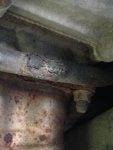I have an 05 OB LLB 3.0. It has 144, miles on it. I went to change the coolant and luckily decided to drop the lower plastic cover so that I could also replace the thermostat and lower rad hose.Its a good thing I did. I immediately saw that the metal coolant pipes are so rusted that they are about to burst. The pipe on the drivers side looks very difficult to replace.
The other pipe that runs across the bottom front of the engine is easy to change out. Does anyone here know about this issue and has anybody replaced the difficult one that runs up to the back of the engine where it tees off to the heater hoses? Advice on this project or a tutorial on it would be great. thanks
The other pipe that runs across the bottom front of the engine is easy to change out. Does anyone here know about this issue and has anybody replaced the difficult one that runs up to the back of the engine where it tees off to the heater hoses? Advice on this project or a tutorial on it would be great. thanks






